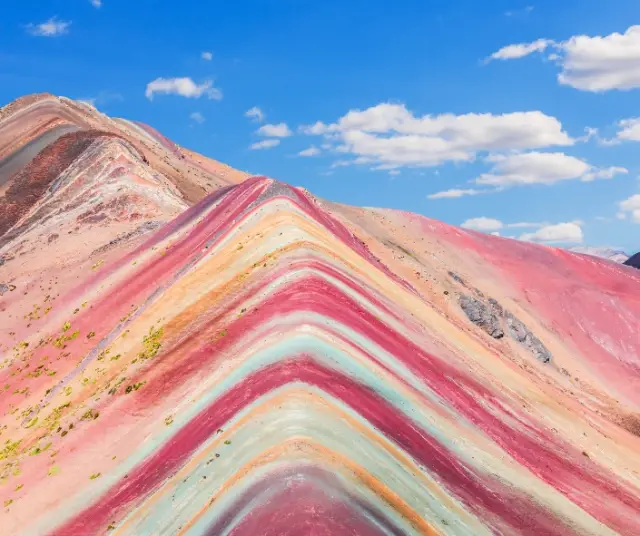Peru, a country known for its rich history, cultural legacy and impressive variety of natural landscapes, is home to a particular gem that has captured the imagination of travelers and adventurers around the world: Vinicunca, also known as the Mountain of Seven Colors or Rainbow Mountain. This natural phenomenon, located in the southern region of Peru, has emerged as one of the most fascinating and sought-after tourist destinations in recent years.
Vinicunca is located in the Andes Mountains, specifically in the Cusco region, near the famous archaeological site of Machu Picchu. At an altitude of approximately 5,200 meters above sea level, this mountain offers an impressive visual spectacle that seems straight out of a dream. Its vibrant colors, ranging from deep red to emerald green, were formed due to the presence of various minerals in the layers of the earth over millions of years.
Vinicunca's impressive variety of colors is mainly due to erosion, which has exposed different geological strata. The hues of the minerals present in these layers include red, green, yellow, white and blue, creating a dazzling visual effect that attracts visitors from all over the world.
History and Cultural Significance
The history of Vinicunca is intertwined with the rich Andean worldview and the ancestral traditions of the indigenous communities that have inhabited the Andes region for millennia. For these cultures, mountains are not only geographical formations, but they are also sacred entities that embody divinities, protective spirits and forces of nature.
Vinicunca, known as the Mountain of Seven Colors or the Rainbow Mountain, has been revered by local communities long before modern tourism discovered its beauty. For centuries, the indigenous populations that lived near the mountain performed rituals and ceremonies in honor of this imposing colossus of nature.
For these communities, Vinicunca is much more than an impressive visual spectacle; It is a symbol of connection with the land and with your ancestors. The mountain is believed to be a meeting point between the earthly and spiritual worlds, a place where cosmic energies converge and where nature spirits reside.
The rituals performed in Vinicunca were closely linked to agriculture and livestock, two fundamental activities for the subsistence of Andean communities. Offerings were offered to the mountain as a sign of gratitude for the abundant harvests, for the fertility of the land and for the protection of the herds of llamas and alpacas.
The arrival of tourism has brought with it new challenges and opportunities for local communities who consider Vinicunca as an integral part of their cultural heritage. While tourism has generated economic income for these communities, it has also raised questions about the preservation of their traditions and values.
Impact of Tourism in Vinicunca
The growing interest in Vinicunca has generated a significant increase in tourism in the Cusco region. Thousands of visitors come each year to witness the unique beauty of Seven Color Mountain, which has boosted the local economy but also posed challenges in terms of environmental and cultural management.
The massive influx of tourists has raised concerns about the conservation of Vinicunca's natural environment. Erosion caused by constant foot traffic can have a negative impact on the stability of the exposed geological layers, putting the very beauty of the mountain at risk. It is crucial to implement sustainable management measures that limit the number of daily visitors, establish defined trails and promote responsible tourism practices.
In addition to environmental challenges, the increase in tourism also raises issues related to cultural preservation and respect for local communities. It is important to involve indigenous communities in tourism development and ensure that their traditions and ways of life are respected. Open dialogue and collaboration between government authorities, tourism businesses and local communities are essential to address these challenges effectively.
Promoting Responsible Tourism
Despite the challenges associated with tourism in Vinicunca, this mountain remains a unique destination that offers an unparalleled experience for travelers seeking to connect with nature and culture. To ensure that Vinicunca can continue to be enjoyed by future generations, it is crucial to promote responsible and sustainable tourism.
This involves educating visitors about the importance of preserving the natural environment and respecting local traditions. It also means supporting community development initiatives that empower local communities and provide them with equitable benefits from tourism. In addition, it is necessary to implement environmental conservation measures that protect the biodiversity and unique landscapes of the region.
Tourism in Vinicunca has the potential to be a positive force for the economic and cultural development of the Cusco region, as long as environmental and social impacts are appropriately managed. By taking a holistic approach that prioritizes sustainability and respect for nature and local communities, we can ensure that Vinicunca remains a natural treasure for generations to come.
To ensure the preservation of Vinicunca and its environment, it is essential to adopt a responsible tourism approach that balances economic development with environmental conservation and respect for local communities. Only in this way can we ensure that this natural jewel continues to be enjoyed by future generations, as a reminder of the incredible diversity and beauty of our planet.
